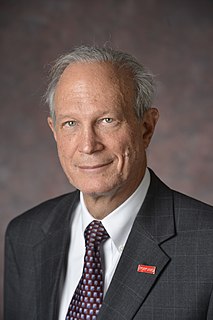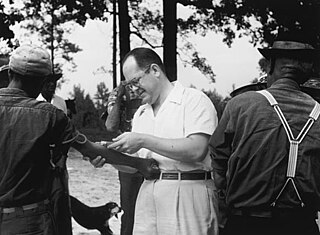
A sebaceous gland is a microscopic exocrine gland in the skin that opens into a hair follicle to secrete an oily or waxy matter, called sebum, which lubricates the hair and skin of mammals. In humans, sebaceous glands occur in the greatest number on the face and scalp, but also on all parts of the skin except the palms of the hands and soles of the feet. In the eyelids, meibomian glands, also called tarsal glands, are a type of sebaceous gland that secrete a special type of sebum into tears. Surrounding the female nipple, areolar glands are specialized sebaceous glands for lubricating the nipple. Fordyce spots are benign, visible, sebaceous glands found usually on the lips, gums and inner cheeks, and genitals.

Hidradenitis suppurativa (HS), sometimes known as acne inversa or Verneuil's disease, is a long-term dermatological condition characterized by the occurrence of inflamed and swollen lumps. These are typically painful and break open, releasing fluid or pus. The areas most commonly affected are the underarms, under the breasts, and the groin. Scar tissue remains after healing. HS may significantly limit many everyday activities, for instance, walking, hugging, moving, and sitting down. Sitting disability may occur in patients with lesions in sacral, gluteal, perineal, femoral, groin or genital regions; and prolonged periods of sitting down itself can also worsen the condition of the skin of these patients.

Tretinoin, also known as all-trans retinoic acid (ATRA), is a medication used for the treatment of acne and acute promyelocytic leukemia. For acne, it is applied to the skin as a cream, gel or ointment. For leukemia, it is taken by mouth for up to three months. Topical tretinoin is also the most extensively investigated retinoid therapy for photoaging.

Rosacea is a long-term skin condition that typically affects the face. It results in redness, pimples, swelling, and small and superficial dilated blood vessels. Often, the nose, cheeks, forehead, and chin are most involved. A red, enlarged nose may occur in severe disease, a condition known as rhinophyma.

Darier's disease (DAR) is an inherited skin disorder that presents with multiple greasy, crusting, thick brown bumps that merge into patches.

Pityriasis rosea is a type of skin rash. Classically, it begins with a single red and slightly scaly area known as a "herald patch". This is then followed, days to weeks later, by a rash of many similar but smaller round or oval lesions, mainly on the trunk and upper limbs. About 20% of cases show atypical deviations from this pattern. It usually lasts less than three months and goes away without treatment. Sometimes malaise or a fever may occur before the start of the rash or itchiness, but often there are few other symptoms.

Holmesburg began as a Village within Lower Dublin Township, Pennsylvania. It is now a neighborhood in the Northeast section of Philadelphia, Pennsylvania. Holmesburg was named in Honor of Surveyor General of Pennsylvania Thomas Holme, who was a cartographer.
Natural skin care uses topical creams and lotions made of ingredients available in nature. Much of the recent literature reviews plant-derived ingredients, which may include herbs, roots, flowers and essential oils, but natural substances in skin care products include animal-derived products such as beeswax, and minerals. These substances may be combined with various carrier agents, preservatives, surfactants, humectants and emulsifiers.

Livedo reticularis is a common skin finding consisting of a mottled reticulated vascular pattern that appears as a lace-like purplish discoloration of the skin. The discoloration is caused by reduction in blood flow through the arterioles that supply the cutaneous capillaries, resulting in deoxygenated blood showing as blue discoloration. This can be a secondary effect of a condition that increases a person's risk of forming blood clots, including a wide array of pathological and nonpathological conditions. Examples include hyperlipidemia, microvascular hematological or anemia states, nutritional deficiencies, hyper- and autoimmune diseases, and drugs/toxins.

Robert Allen Schwartz is an American physician, biomedical researcher, university professor, and government official. He is Professor and Head of Dermatology, Professor of Medicine, Professor of Pediatrics, and Professor of Preventive Medicine and Community Health at the Rutgers New Jersey Medical School, Visiting Professor and Scholar of Public Affairs and Administration at the Rutgers School of Public Affairs and Administration, and serves on the Rutgers University Board of Trustees. He has made seminal contributions to medicine, including the discovery of AIDS-associated Kaposi sarcoma (KS-AIDS) and Schwartz–Burgess syndrome. In 2019 Schwartz joined the Trump administration as a member of the Presidential Advisory Council on HIV/AIDS.
Readily visible alterations of the skin surface have been recognized since the dawn of history, with some being treated, and some not. One of the earliest known sources documenting skin ailments is the Ebers Papyrus, a medical document from ancient Egypt dating to around 1500 BC. It describes various skin diseases, including ulcers, rashes, and tumors, and prescribes surgery and ointments to treat the ailments.

Holmesburg Prison, given the nickname "The Terrordome," was a prison operated by the city of Philadelphia, Pennsylvania and the Pennsylvania Department of Prisons (PDP) from 1896 to 1995. The facility is located at 8215 Torresdale Ave in the Holmesburg section of Philadelphia. It was decommissioned in 1995 when it closed. As of today, the structure still stands and is occasionally used for prisoner overflow and work programs.

Numerous experiments which are performed on human test subjects in the United States are considered unethical, because they are illegally performed or they are performed without the knowledge, consent, or informed consent of the test subjects. Such tests have been performed throughout American history, but most of them are ongoing. The experiments include the exposure of humans to many chemical and biological weapons, human radiation experiments, injections of toxic and radioactive chemicals, surgical experiments, interrogation and torture experiments, tests which involve mind-altering substances, and a wide variety of other experiments. Many of these tests are performed on children, the sick, and mentally disabled individuals, often under the guise of "medical treatment". In many of the studies, a large portion of the subjects were poor, racial minorities, or prisoners.
Albert Montgomery Kligman was an American dermatologist who co-invented Retin-A, the acne medication, with James Fulton in 1969. Kligman is known for the medical experiments he performed on inmates at Holmesburg Prison in Philadelphia, and the resulting scandal that followed years later. The experiments intentionally exposed humans to pathogens and the chemical warfare agent dioxin, and later became a textbook example of unethical experimenting on humans. He and others involved were sued for alleged injuries, but the lawsuit was dismissed due to the statute of limitations expiring.

Prison healthcare is the medical specialty in which healthcare providers care for people in prisons and jails. Prison healthcare is a relatively new specialty that developed alongside the adaption of prisons into modern disciplinary institutions. Enclosed prison populations are particularly vulnerable to infectious diseases, including arthritis, asthma, hypertension, cervical cancer, hepatitis, tuberculosis, AIDS, and HIV, and mental health issues, such as Depression, mania, anxiety, and post-traumatic stress disorder. These conditions link prison healthcare to issues of public health, preventive healthcare, and hygiene. Prisoner dependency on provided healthcare raises unique problems in medical ethics.

Allen M. Hornblum is an author, journalist and a former criminal justice official and political organizer based in Philadelphia, USA. He has written seven non-fiction books running the gamut from organized crime and Soviet espionage to medical ethics and sports. His first book, Acres of Skin, published in 1998, detailed unethical human medical experiments at Holmesburg Prison. The publication of Acres of Skin attracted considerable international media interest. Subsequently, Hornblum wrote Sentenced to Science, a book about the experience of an African American inmate in Holmesburg prison.

Ian Wesley Whimster MRCPath was a reader of dermatology histopathology at St Thomas' Hospital, London. He gained international recognition for his study of comparative anatomy and experiments with reptiles, particularly observing their colour patterns in relation to their nerve supply. He was part of the medical student team that went into Bergen-Belsen concentration camp in 1945, after it was liberated by British troops. On return, he made numerous contributions to dermatology, including the definition of keratoacanthoma, the distinction between pemphigus and pemphigoid and descriptions of melanocytes and malignant melanoma. He died in a road traffic accident at the age of 55.
Prison plastic surgery is plastic surgery or cosmetic surgery offered and performed to people who are incarcerated, as a means of social rehabilitation. These services were normally provided as part of a larger package of care that may include work training, psychological services, and more. Popular surgeries included rhinoplasties, blepharoplasty, facelifts, scar removal and tattoo removal. These programs began in the early 20th century and were commonplace up till the early 1990s. They took place across the US, the UK, Canada, and Mexico.
Günter Burg is a German dermatologist. Born in Mayen, Germany, he holds German and Swiss citizenship. He has been married to Dr. Doris Burg-Nicklas, a neurologist, since 1968. They have two sons: Andreas and Thomas.














